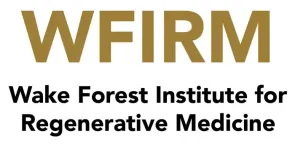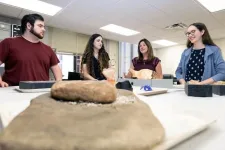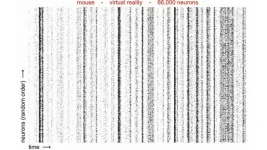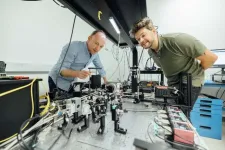(Press-News.org) The ideal material for interfacing electronics with living tissue is soft, stretchable, and just as water-loving as the tissue itself—in short, a hydrogel. Semiconductors, the key materials for bioelectronics such as pacemakers, biosensors, and drug delivery devices, on the other hand, are rigid, brittle, and water-hating, impossible to dissolve in the way hydrogels have traditionally been built.
A paper published today in Science from the UChicago Pritzker School of Molecular Engineering (PME) has solved this challenge that has long stymied researchers, reimagining the process of creating hydrogels to build a powerful semiconductor in hydrogel form. Led by Asst. Prof. Sihong Wang’s research group, the result is a bluish gel that flutters like a sea jelly in water but retains the immense semiconductive ability needed to transmit information between living tissue and machine.
The material demonstrated tissue-level moduli as soft as 81 kPa, stretchability of 150% strain, and charge-carrier mobility up to 1.4 cm2 V-1 s-1. This means their material—both semiconductor and hydrogel at the same time—ticks all the boxes for an ideal bioelectronic interface.
“When making implantable bioelectronic devices, one challenge you must address is to make a device with tissue-like mechanical properties,” said Yahao Dai, the first author of the new paper. “That way, when it gets directly interfaced with the tissue, they can deform together and also form a very intimate bio-interface.”
Although the paper mainly focused on the challenges facing implanted medical devices such as biochemical sensors and pacemakers, Dai said the material also has many potential non-surgical applications, like better readings off the skin or improved care for wounds.
“It has very soft mechanical properties and a large degree of hydration similar to living tissue,” said UChicago PME Asst. Prof. Sihong Wang. “Hydrogel is also very porous, so it allows the efficient diffusion transport of different kinds of nutrition and chemicals. All these traits combine to make hydrogel probably the most useful material for tissue engineering and drug delivery.”
'Let’s change our perspective’
The typical way of making a hydrogel is to take a material, dissolve it in water, and add the gelation chemicals to puff the new liquid into a gel form. Some materials simply dissolve in water, others require researchers to tinker and chemically modify the process, but the core mechanism is the same: No water, no hydrogel.
Semiconductors, however, don’t normally dissolve in water. Rather than find new, time-consuming means of trying to force the process, the UChicago PME team re-examined the question.
“We started to think, ‘Okay, let's change our perspective,’ and we came up with a solvent exchange process,” Dai said.
Instead of dissolving the semiconductors in water, they dissolved them in an organic solvent that is miscible with water. They then prepared a gel from the dissolved semiconductors and hydrogel precursors. Their gel initially was an organogel, not a hydrogel.
“To eventually turn it into a hydrogel, we then immersed the whole material system into the water to let the organic solvent dissolve out and let the water come in,” Dai said.
An important benefit of such a solvent-exchange-based method is its broad applicability to different types of polymer semiconductors with different functions.
‘One plus one is greater than two’
The hydrogel semiconductor, which the team has patented and is commercializing through UChicago’s Polsky Center for Entrepreneurship and Innovation, is not merging a semiconductor with a hydrogel. It’s one material that is both semiconductor and hydrogel at the same time.
“It’s just one piece that has both semiconducting properties and hydrogel design, meaning that this whole piece is just like any other hydrogel,” Wang said.
Unlike any other hydrogel, however, the new material actually improved biological functions in two areas, creating better results than either hydrogel or semiconductor could accomplish on their own.
First, having a very soft material bond directly with tissue reduces the immune responses and inflammation typically triggered when a medical device is implanted.
Second, because hydrogels are so porous, the new material enables elevated biosensing response and stronger photo-modulation effects. With biomolecules being able to diffuse into the film to have volumetric interactions, the interaction sites for biomarkers-under-detection are significantly increased, which gives rise to higher sensitivity. Besides sensing, the responses to light for therapeutic functions at tissue surfaces also get increased from the more efficient transport of redox-active species. This benefits functions such as light-operated pacemakers or wound dressing that can be more efficiently heated with a flick of light to help speed healing.
“It’s a ‘one plus one is greater than two’ kind of combination,” Wang joked.
Citation: “Soft hydrogel semiconductors with augmented biointeractive functions,” Dai et al., Science, October 24, 2024. DOI: 10.1126/science.adp9314
Funding: This work was supported by the US National Institutes of Health Director’s New Innovator Award (1DP2EB034563) and the US Office of Naval Research (N00014-21-1-2266). This work was partially supported by the start-up fund from the University of Chicago.
END
A new hydrogel semiconductor represents a breakthrough for tissue-interfaced bioelectronics
New material from the UChicago Pritzker School of Molecular Engineering can create better brain-machine interfaces, biosensors, and pacemakers
2024-10-24
ELSE PRESS RELEASES FROM THIS DATE:
Bird study finds sons help their parents less than daughters because they’re scouting future prospects
2024-10-24
Male birds help their parents less than females because they’re too busy scouting for new places to live and breed, a remarkable new study shows.
The study, led by researchers at the Centre for Ecology and Conservation at the University of Exeter, examined the cooperative behaviour and movement patterns of social birds called white-browed sparrow weavers, which live in the Kalahari desert.
These birds live in family groups in which only a dominant pair breeds – and their grown-up offspring, particularly females, help ...
Wake Forest Institute for Regenerative Medicine (WFIRM) awarded up to $48 million to utilize body-on-a-chip technologies to study fibrosis-inducing chemical injuries
2024-10-24
The Wake Forest Institute for Regenerative Medicine (WFIRM) has been awarded an eight-year contract, valued up to $48 million from the U.S. Department of Health and Human Services (HHS) to support the utilization of cutting-edge body-on-a-chip technologies aimed at studying and developing potential treatments for sulfur mustard and other fibrosis-inducing chemicals. The program has been approved with an initial contracting commitment of approximately $18 million.
This contract represents a continued partnership between WFIRM and the Biomedical Advanced Research and Development Authority (BARDA), ...
Study offers ‘compelling evidence’ for continuous stroke care improvement
2024-10-24
Research Highlights:
A retrospective look at Get With The Guidelines® – Stroke registry data from 2003 to 2022 finds substantial and sustained improvements in acute stroke care among those in the quality improvement program.
Researchers found increased adherence to evidence-based stroke care translates to better clinical outcomes and, ultimately, more patients being discharged home or to a skilled nursing facility more quickly.
Overall, authors say the positive trends suggest concerted quality improvement initiatives can improve ...
Professor awarded NEH grant to advance anthropology research collections at Texas A&M
2024-10-24
Dr. Katie Custer Bojakowski, an instructional assistant professor in the Department of Anthropology at Texas A&M University and the director and curator of its Anthropology Research Collections (ARC), has been awarded a Preservation Assistance Grant from the National Endowment for the Humanities (NEH).
The NEH’s Preservation Assistance Grants program helps organizations protect their collections of historical and cultural items, making sure they remain available for students, scholars and the public. These grants help address risks to these collections, ...
New tool helps scientists spot patterns in mountains of data
2024-10-24
Neuroscientists have learned a lot – like which neurons and circuits are associated with different behaviors – by recording the activity of small sets of neurons.
But what happens when you record thousands of neurons at one time? Or when you want to figure out the role of neurons when there isn’t an obvious external catalyst or you’re not sure what you’re even looking for?
That’s where Rastermap comes in.
The new visualization tool developed by the Stringer and Pachitariu labs at HHMI's Janelia Research Campus helps ...
Glomerular filtration rate changes following UTI in children with vesicoureteral reflux
2024-10-24
About The Study: This cohort study uses data from the Children With Vesicoureteral Reflux trial to assess estimated glomerular filtration rate (eGFR) changes in participants with vs without recurrent urinary tract infections.
Corresponding Author: To contact the corresponding author, David S. Hains, MD, MBA, email dhains@iu.edu.
To access the embargoed study: Visit our For The Media website at this link https://media.jamanetwork.com/
(doi:10.1001/jamapediatrics.2024.4546)
Editor’s Note: Please see the article for additional information, including other authors, author contributions ...
Dandelion-shaped supernova and zombie star
2024-10-24
In 1181, a new star shone near the Cassiopeia constellation for six months before disappearing. This event, recorded as a “guest star” by Chinese and Japanese observers almost a millennium ago, has puzzled astronomers for centuries. It is one of a few supernovae to be documented before the invention of telescopes. In addition, it remained an “orphan” the longest, meaning that none of the celestial objects visible today could be assigned to it. Now known as the supernova SN 1181, its remnant has only been traced in 2021 to the nebula ...
Experts call for clear and concise regulation of exosome-based treatments
2024-10-24
Clinics that offer exosome therapies claim they have the ability to repair and regenerate tissues and treat inflammatory and other immune-related conditions in a noninvasive way. Now, a team of bioethicists and legal scholars from Japan is sounding the alarm on the urgent need for stronger regulations surrounding these unproven interventions. Their letter appears October 24 in the journal Stem Cell Reports.
“Administering these treatments to patients without scientific evidence or a clear ...
Zebrahub: New atlas tracks zebrafish development like never before
2024-10-24
When early cartographers undertook perilous expeditions to map unknown corners of the world with sextants, compasses, and hand-drawn diagrams, it’s unlikely they imagined that someday anyone with an internet connection would have access to a seamless view of the entire planet from the comfort of their own home. Today, pioneering scientists are working to create a similar experience for a much tinier, but no less important domain: developing embryos. The goal is to track and map the behavior of each and every cell working together to create an adult lifeform, and present that map in a clickable, ...
Unnoticeable electric currents could reduce skin infections
2024-10-24
Using a few zaps of electricity to the skin, researchers can stop bacterial infections without using any drugs. For the first time, researchers designed a skin patch that uses imperceptible electric currents to control microbes. The results appear October 24 in the Cell Press journal Device.
“This opens up exciting possibilities for drug-free treatments, especially for skin infections and wound healing, where antibiotic-resistant bacteria pose a serious challenge,” says University of Chicago’s Bozhi Tian, one of the paper’s ...
LAST 30 PRESS RELEASES:
Numbers in our sights affect how we perceive space
SIMJ announces global collaborative book project in commemoration of its 75th anniversary
Air pollution exposure and birth weight
Obstructive sleep apnea risk and mental health conditions among older adults
How talking slows eye movements behind the wheel
The Ceramic Society of Japan’s Oxoate Ceramics Research Association launches new international book project
Heart-brain connection: international study reveals the role of the vagus nerve in keeping the heart young
Researchers identify Rb1 as a predictive biomarker for a new therapeutic strategy in some breast cancers
Survey reveals ethical gaps slowing AI adoption in pediatric surgery
Stimulant ADHD medications work differently than thought
AI overestimates how smart people are, according to HSE economists
HSE researchers create genome-wide map of quadruplexes
Scientists boost cell "powerhouses" to burn more calories
Automatic label checking: The missing step in making reliable medical AI
Low daily alcohol intake linked to 50% heightened mouth cancer risk in India
American Meteorological Society announces Rick Spinrad as 2026 President-Elect
Biomass-based carbon capture spotlighted in newly released global climate webinar recording
Illuminating invisible nano pollutants: advanced bioimaging tracks the full journey of emerging nanoscale contaminants in living systems
How does age affect recovery from spinal cord injury?
Novel AI tool offers prognosis for patients with head and neck cancer
Fathers’ microplastic exposure tied to their children’s metabolic problems
Research validates laboratory model for studying high-grade serous ovarian cancer
SIR 2026 delivers transformative breakthroughs in minimally invasive medicine to improve patient care
Stem Cell Reports most downloaded papers of 2025 highlight the breadth and impact of stem cell research
Oxford-led study estimates NHS spends around 3% of its primary and secondary care budget on the health impacts of heat and cold in England
A researcher’s long quest leads to a smart composite breakthrough
Urban wild bees act as “microbial sensors” of city health.
New study finds where you live affects recovery after a hip fracture
Forecasting the impact of fully automated vehicle adoption on US road traffic injuries
Alcohol-related hospitalizations from 2016 to 2022
[Press-News.org] A new hydrogel semiconductor represents a breakthrough for tissue-interfaced bioelectronicsNew material from the UChicago Pritzker School of Molecular Engineering can create better brain-machine interfaces, biosensors, and pacemakers





